
My art is firmly rooted in the understanding that the primary success and value of a work of art is determined by whether the direct sensory perception of the work triggers a “mega-whallop” of satisfying intuitive pleasure in the viewer. Nothing more is asked, nothing less is expected.
I do not make this assertion lightly. I am only too painfully aware of the difficulty of achieving this goal but this is the core challenge I embraced when I chose to dedicate my life to the pursuit of beauty and visual integrity through painting.
Having emphasized the primacy of the observable characteristics of my paintings, I am nonetheless aware that with just about any artwork there are underlying layers of content that can provide information that encourages a prolonged engagement in the process of looking. Prolonged engagement is a good thing. However, while these layers are not, in themselves, irrelevant, they are not necessary for perceptual enjoyment. This means that if your time is limited please focus on the paintings.
Underlying Content: The primary focus of the majority of my thirty–five years art career had been to paint dramatic representational narratives in which single or multiple human figures were depicted in reflective poses in interior spaces.
However, in the summer of 2010 I radically changed direction and began a series of twenty-eight oil paintings depicting the standing stone circle at Stonehenge surrounded by dramatic skies (sunsets, sunrises, or moon risings). This change was inspired by a serendipitous coalescence of barely related concepts and ineffable personal experiences the roots of which date back to 1972.
I was 26 years old when I was first heard about Stonehenge. I had just started art school. Previously, I had been working with emotionally disturbed adolescents (four years) but had found that work to be less satisfying than I had hoped so, in search of a new career path, I enrolled as a first year student in a local university fine art program. In all honesty, my decision to study art took my friends and family by surprise given that I had had very little connection to the world of art beyond an above-average facility for observational drawing. So little connection, in fact, that I was not even aware that observational drawing had been out of vogue in the “art world” for more than fifty years. Armed with little more than foolish innocence and enthusiasm I enrolled for classes.
As strange as it may seem, whatever insecurities I had about enrolling in art school inexplicably evaporated in the first fifteen minutes of my very first class when the art history professor teaching the introductory ancient art survey projected grainy black and white slides of Stonehenge on the classroom wall. The moment I saw photo-graphs of the monument I felt a palpable connection to both the monument and to the intelligence of the artists who had created it. In that moment these images of a four thousand year-old Neolithic monument solidified my trust in my intuition and, because they opened my eyes to how effective the visual arts can be as a tool for condensing and communicating the wonder of the shared human experience across time and space, rendered permanent my commitment to pursue a life in art.
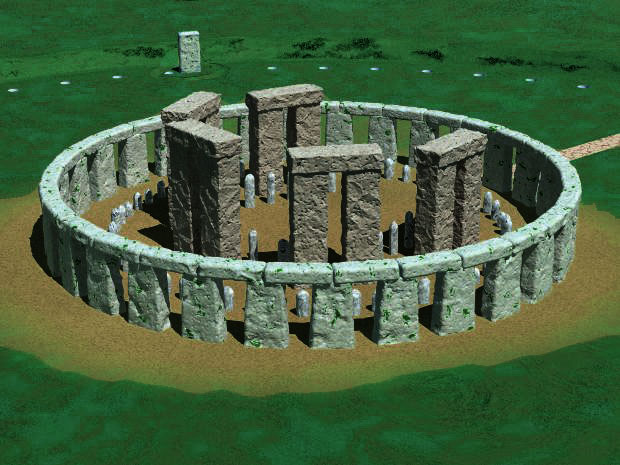
Artist rendering of the original appearance of Stonehenge
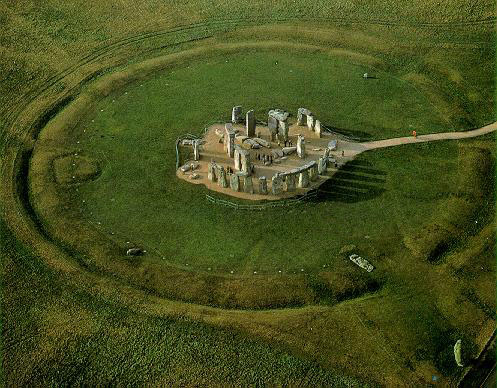
Arial view of the multiple stages of the construction of Stonehenge as it appears today
Several weeks after that transformative experience I was fortunate enough to come across an intriguing sentence in my Art History textbook (Janson’s History of Art) that would amplify my interest in the power of art while adding considerable depth to my understanding of how art makes meaning. The sentence was contained in the lesson on the Parthenon. Janson noted that this remarkably beautiful structure was designed to embody a proportion known as the Golden Mean and that the Ancient Greeks believed that this infinitely regenerating proportion was the key to understanding the secrets of the cosmos. An amazing statement. I need to know more. I eagerly turned the page only to find that Janson, unfathomably, had written absolutely nothing more on the subject. I was as frustrated as I was intrigued and I was very intrigued.
My search for information on the Golden Mean began immediately. I encountered slow going at first. Remember, this was pre-Google. Libraries and bookstores were our storehouses of information back then and the few books I could locate focused primarily on the Golden Mean as a design template for artists. Despite the fact that I identify first and foremost as a studio artist I nonetheless felt a profound need to find out why the Greeks believed the Golden Mean Ratio to be a foundational spiritual, philosophical, and/or scientific principle. Even though my research accumulated very slowly I eventually connected the Greeks' reverence of the Golden Mean to a mystical/mathematical tradition in Athens known as the Pythagorean Brotherhood. The Brotherhood’s beliefs were as follows:
Nature and the whole of reality has an underlying mathematical structure
That philosophy was a tool for spiritual purification
That the pure soul can rise to experience the union with the divine
That certain mathematical symbols (especially the Golden Mean) have a mystical significance.
In less than three weeks art school had both provided me a transformative perceptual experience that cemented my commitment to the ability of images to trigger empathetic connections across time and space with the subjects depicted but also introduced me to an ancient mystical tradition that I was later to find out was embedded in the very origins of Western rationalism.
Seven years later, after completing a BA in Art History and a BFA and MFA in painting, I began what has turned into a lifelong career as an art professor. My first teaching job at a small liberal arts college included Art History lecturing as well as teaching drawing and painting. I quickly found that my background in Art History added resonance to my studio teaching and my background in studio provided experiential insights when studying and/or lecturing on Art History. Through this amalgam I came to better understand the central position that art occupies in culture and came to understand that courses in both studio and Art History can and should reference the broadest spectrum of academic disciplines.
In keeping with this new-found understanding of the multiple layers of content underlying art images I began integrating the history of the tradition of sacred geometry into both my Art History lectures and my studio presentations. In the process of preparing 35mm slides for these lectures I began using a ruler to analyze the internal proportions of artworks from both the Western and non-Western canon of art masterpieces. Starting with the Parthenon, for which there is historical evidence that it was designed to embody the proportion of the Golden Mean, I went on to analyze hundreds of fine art images. The high frequency of appearance of this proportion in strategic places in teh design of architecture and painting served to progressively stimulate my curiosity. The process got much more efficient in the mid-nineties when I learned how to overlay a diagram of the Golden Rectangle on an artwork using Photoshop. With this tool I analyzed hundreds more images ranging from astronomical photographs of spiral nebula, meteorological images of hurricanes, mathematically generated computer images of random fractal patterns (chaos), varieties of biological life forms, to the design of the one-dollar bill. From this analysis I came to understand how profoundly the Golden Mean is woven into the very fabric of our visible world (for any who would like more specific information about this unique and fascinating proportion and its relationship to history, science, art, and spiritual traditions I refer you to the thirty page chapter, The Golden Mean, in my introductory perceptual drawing textbook, Drawing from Observation 2e, McGraw-Hill Higher Education, 2010)
Several weeks after that transformative experience I was fortunate enough to come across an intriguing sentence in my Art History textbook (Janson’s History of Art) that would amplify my interest in the power of art while adding considerable depth to my understanding of how art makes meaning. The sentence was contained in the lesson on the Parthenon. Janson noted that this remarkably beautiful structure was designed to embody a proportion known as the Golden Mean and that the Ancient Greeks believed that this infinitely regenerating proportion was the key to understanding the secrets of the cosmos. An amazing statement. I need to know more. I eagerly turned the page only to find that Janson, unfathomably, had written absolutely nothing more on the subject. I was as frustrated as I was intrigued and I was very intrigued.
My search for information on the Golden Mean began immediately. I encountered slow going at first. Remember, this was pre-Google. Libraries and bookstores were our storehouses of information back then and the few books I could locate focused primarily on the Golden Mean as a design template for artists. Despite the fact that I identify first and foremost as a studio artist I nonetheless felt a profound need to find out why the Greeks believed the Golden Mean Ratio to be a foundational spiritual, philosophical, and/or scientific principle. Even though my research accumulated very slowly I eventually connected the Greeks' reverence of the Golden Mean to a mystical/mathematical tradition in Athens known as the Pythagorean Brotherhood. The Brotherhood’s beliefs were as follows:
Nature and the whole of reality has an underlying mathematical structure
That philosophy was a tool for spiritual purification
That the pure soul can rise to experience the union with the divine
That certain mathematical symbols (especially the Golden Mean) have a mystical significance.
In less than three weeks art school had both provided me a transformative perceptual experience that cemented my commitment to the ability of images to trigger empathetic connections across time and space with the subjects depicted but also introduced me to an ancient mystical tradition that I was later to find out was embedded in the very origins of Western rationalism.
Seven years later, after completing a BA in Art History and a BFA and MFA in painting, I began what has turned into a lifelong career as an art professor. My first teaching job at a small liberal arts college included Art History lecturing as well as teaching drawing and painting. I quickly found that my background in Art History added resonance to my studio teaching and my background in studio provided experiential insights when studying and/or lecturing on Art History. Through this amalgam I came to better understand the central position that art occupies in culture and came to understand that courses in both studio and Art History can and should reference the broadest spectrum of academic disciplines.
In keeping with this new-found understanding of the multiple layers of content underlying art images I began integrating the history of the tradition of sacred geometry into both my Art History lectures and my studio presentations. In the process of preparing 35mm slides for these lectures I began using a ruler to analyze the internal proportions of artworks from both the Western and non-Western canon of art masterpieces. Starting with the Parthenon, for which there is historical evidence that it was designed to embody the proportion of the Golden Mean, I went on to analyze hundreds of fine art images. The high frequency of appearance of this proportion in strategic places in the design of architecture and painting served to progressively stimulate my curiosity. The process got much more efficient in the mid-nineties when I learned how to overlay a diagram of the Golden Rectangle on an artwork using Photoshop. With this tool I analyzed hundreds more images ranging from astronomical photographs of spiral nebula, meteorological images of hurricanes, mathematically generated computer images of random fractal patterns (chaos), varieties of biological life forms, to the design of the one-dollar bill. From this analysis I came to understand how profoundly the Golden Mean is woven into the very fabric of our visible world (for any who would like more specific information about this unique and fascinating proportion and its relationship to history, science, art, and spiritual traditions I refer you to the thirty page chapter, The Golden Mean, in my introductory perceptual drawing textbook, Drawing from Observation 2e, Xanedu Publishing, Ann Arbor, MI, 2021)
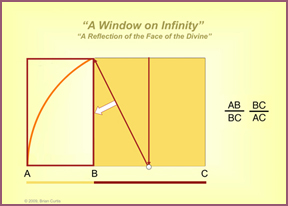
The Golden Mean Proportion can be accurately visualized with a straight edge and a compass
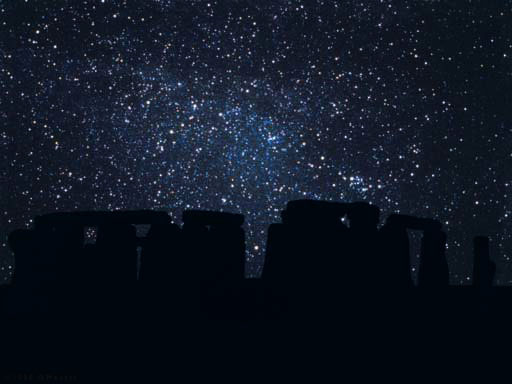
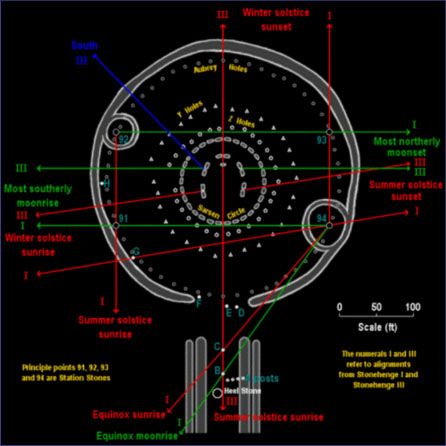
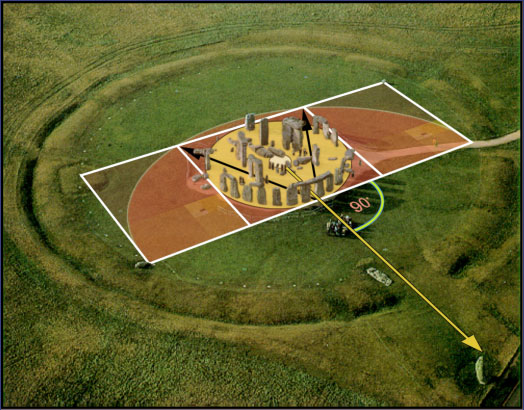

With this discovery my fascination with Stonehenge came full circle encompassing both a direct personal perceptual experience that had resonated deep within my innermost being and a conceptually intriguing mathematical proportion with remarkable properties that has contributed to a long-standing intellectual/spiritual tradition with deep roots in ancient mysticism.
Curiously, however, as fascinated as I had become at finding the Golden Mean proportion in the plan of Stonehenge, the idea of painting a single image much less a series of twenty-eight paintings using Stonehenge and its relationship to sky, sun, and moon as the central image had never occurred to me and most likely never would have were it not for two other precipitating events. The first was an opportunity to actually visit the Stonehenge monument site in May of 2010 while on holiday in the UK and the second, the one that proved to be the pivotal catalyst for my Stonehenge Series project, was a weekend trip to New York City in August of 2010.
When I visited Stonehenge I was part of a professional tour that was only on-site for two hours but I benefited from the fact that the tour took place after-hours. This allowed me to walk in among the large standing stones – up close and personal - something that visitors who come to Stonehenge on their own during regular park hours are not permitted to do. The entire experience was as inspiring as I had hoped. I left Stonehenge with over one-hundred digital images of my own and with a renewed sense of emotional and intellectual attachment to this amazing art work.
Three months later while on a semi-annual cultural pilgrimage to New York City I took an afternoon to visit the Metropolitan Museum of Art where, due to limited time, I decided to narrow my attention to Western representational painting from the 15th to the 19th Centuries. Because I am fairly familiar with these collections at the Met I moved quickly through the galleries only stopping to engage paintings that I knew would reward me with a satisfying "mega-whallop" of perceptual pleasure. Fortunately, the Metropolitan is home to quite a few of these. I liken it to visiting old friends. I was thoroughly enjoying myself and encountering no surprises. That is until, having sprinted unchecked through a large hall of pretentious and superficial portraits of the18th Century gentry, I was surprised to find a small, slightly out-of-the-way gallery that was home to a dozen remarkably engaging landscape paintings in oil from the late 18th century - none of which was larger than 16” x 20”. The immediacy of the paint handling, the intimacy of the scale, the skillful handling of the illusion of light in depicted sunrises, sunsets and moon risings, the strength and simplicity of composition, the transcendental qualities of the depicted nature all combined to stop me in my tracks and reanimated my earlier realization that great emotional energy can be transmitted through skillfully constructed and executed images. I found profundity in their modesty of means and as I exited the museum that afternoon I had begun integrating the myriad of influences I have outlined above and by the time I got back to my studio two days later the Stonehenge Series was well on its way toward actualization.
I was quite satisfied with how smoothly the planning and execution of the first series of 28 paintings proceeded. I worked on all 28 simultaneously for six months – putting finishing touches on each of them in the final weeks. As the project neared completion I began my search for titles. While I knew I would label the entire group the Stonehenge Series I also knew I would be uncomfortable assigning numbers to distinguish one painting from the other. Numbers seemed too abstract and clinical for the multiple layers of content from historical and spiritual traditions and transformative personal experience. As one who has been shaped and influenced throughout my life by a belief in the simple truths found in spiritual stories and mythological traditions it suddenly occurred to me that using names of solar, lunar, sky, and cloud deities from cultures from around the world and across the ages would mesh perfectly with a monument thought by some to be an astronomical observatory and designed with an infinitely regenerating proportion, the Golden Mean. As I collected mythological names it started to feel as though they attached themselves to specific images in in that process reinforcing the the ineffable character and lingering mysterious aura of Stonehenge. As I assigned these names I was pleased to find they not only provided distinctive titles but that they also provided pleasurable sounds when spoken. With the mythological names coupled to the paintings the Stonehenge series was complete.
Looking back on the converging forces that have resulted in over fifty paintings of Stonehenge I am drawn to analyzing the ways that this series has introduced me to new ideas and made me more aware of my immediate environment. No longer do I take for granted the infinite variety in the dramatic summer clouds or the ever-changing majesty of the South Florida sunrises and sunsets. The richness of my daily experience has been enhanced by the intensity of my involvement studying cloud formations. Not only has my work rendering clouds increased perceptiveness but it has also stimulated a profound intellectual fascination with fractal complexity. This was a direct outgrowth of the fact that the most dynamic content of nearly every painting in the Stonehenge Series is the depiction of light playing off the profoundly irregular shapes and contours of clouds. Ironically, the more facile I became in capturing the sense of irregularity in the clouds the more I experienced what I can only describe as an underlying sense of beauty (order) in the randomness. Ironically, the sense of order I perceived while painting the clouds in the Stonehenge Series has been mathematically reinforced by Benoit Mandelbrot’s equation that generates an infinite set of random information, that when plotted on a graphic interface, generates an infinite succession of patterns that contain, at each and every level, precise Golden Mean proportions that are identical in every way to the proportion that informs the design of Stonehenge.

Let me close by restating my conviction that it is through our direct and active sensory engagement with high quality art that we gain access to heightened aesthetic experiences that naturally and dependably reveal the broadest spectrum of our emotions, our intellect, the physical world of which we are a part, and of the breadth and depth of our innermost spiritual understanding.
Brian Curtis
February 16, 2016